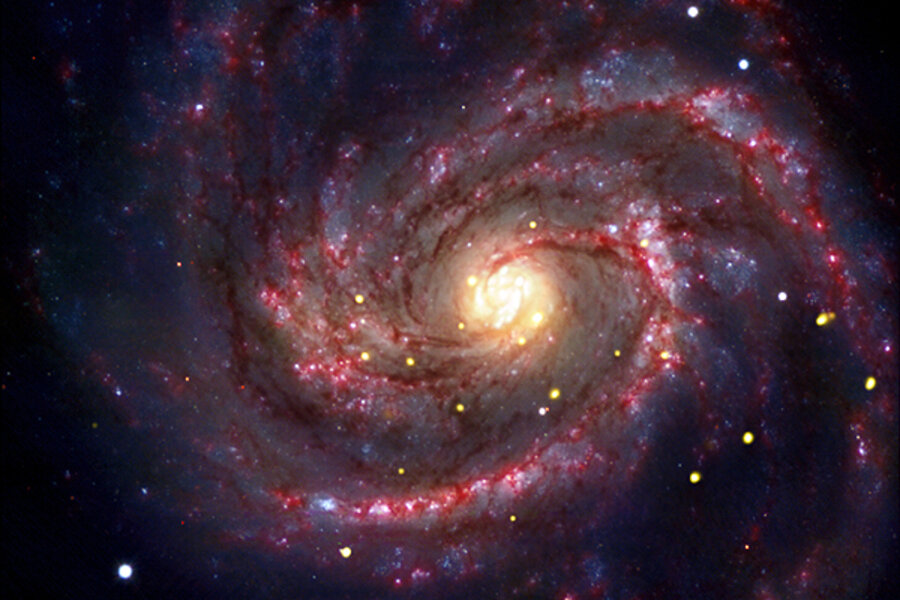Where once a star shone, scientists see evidence of a baby black hole
Loading...
The leftovers from a star that blew up in a galaxy some 50 million light-years away may be giving astrophysicists their first look at an infant black hole – an object whose gravity is so immense that even light fails to travel fast enough to escape its grip.
The evidence comes in the form of X-ray emissions from the object, emissions that can escape because they come from material that is on the verge of being sucked into the cosmic maw, but hasn't been drawn over the brink yet.
The researchers reporting the discovery – a team from the Harvard-Smithsonian Center for Astrophysics in Cambridge, Mass. – caution that at least one other plausible mechanism could be generating the X-rays, such as the one driving emissions from the Crab Nebula, the remains of a star only 21 light years from Earth whose explosion as a supernova sky watchers spotted in 1054 AD.
In that case, no black hole formed from the supernova. Instead, the remnant of the original star is a rapidly spinning neutron star, or pulsar, which packs the mass of an object like the sun into a ball only 12 miles across. Energy from the neutron star excites the shell of material expanding from the original explosion, giving off X-rays as well as radiation at other wavelengths.
Researchers say supernova explosions are far more likely to produce neutron stars than so-called stellar-mass black holes, so if the emissions the team has studied are coming from a black hole, the discovery would offer rare insights into a rare process.
Whatever is driving the X-ray emissions the team tracked, this latest find gives researchers the opportunity to gather long-sought details about the death throes of massive stars – a process that astrophysicists say is responsible for seeding the universe with chemical elements heavier than primordial hydrogen and helium.
"I'm pretty excited about this discovery, regardless of whether it turns out to be a young black hole" or a nebula energized by a pulsar, says Alexei Filippekno, an astronomer at the University of California at Berkeley who studies supernovae and was not a member of the team reporting the results.
A 1979 supernova
The supernova in question was discovered in 1979 by a Maryland school teacher who also was an amateur astronomer. It involved a star in a spiral arm of the galaxy known as M100, located some 50 million light-years from Earth in the constellation Coma Berenices. Astronomers estimate that the progenitor star tipped the cosmic scales at about 20 times the sun's mass.
Over the years astronomers have looked at the blast's aftermath with tools ranging from radio and optical telescopes to several orbiting X-ray observatories, including NASA's Chandra X-Ray Observatory. The X-ray observations span a 12-year period from 1995 to 2007.
Some astrophysicists posited that the driver behind the X-ray emissions could be a bizarre form of neutron star known as a magnetar – an object with an unusually strong magnetic field whose decay over time generates X-rays and gamma rays.
The Harvard-Smithsonian team tested that idea by pulling all the X-ray data they could find on M100's blast, supernova 1979C, and checking it for trends in the steadiness of emissions. Those emissions should decline as the magnetic field does, explains Avi Loeb, one of the team members.
X-ray emissions steady
Oddly, while the radio and optical-light emissions have faded with time, as expected, the object's X-ray emissions have remained steady.
Moreover, the emissions' intrinsic X-ray brightness is virtually identical with the upper limit of brightness that theory predicts for a well-fed stellar-mass black hole, a black hole with between five and 10 time's the sun's mass, Dr. Loeb explains.
A supernova remnant with a pulsar at its center instead of a black hole in principle could generate a steady x-ray signature like 1979C's, Loeb acknowledges. But so many conditions would have to be just right that it would be a rare coincidence for them to align in a way that would mimic the X-ray data the team uncovered, he says.
The best way to distinguish between pulsar and black hole for this object is to continue observations, notes Harvard-Smithsonian researcher Daniel Patnaude, who led the study. Giving Chandra longer stare time at the object would allow scientists to tease out details within the spread of X-ray wavelengths Chandra detects. The tell-tale fingerprint of either process will be written in those details, Dr. Patnaude says.
Armed with those "baby" fingerprints, astrophysicist also would be in a position to conduct a reliable census of stellar-mass black holes as they scan the skies for past and present supernovae, the researchers say.





